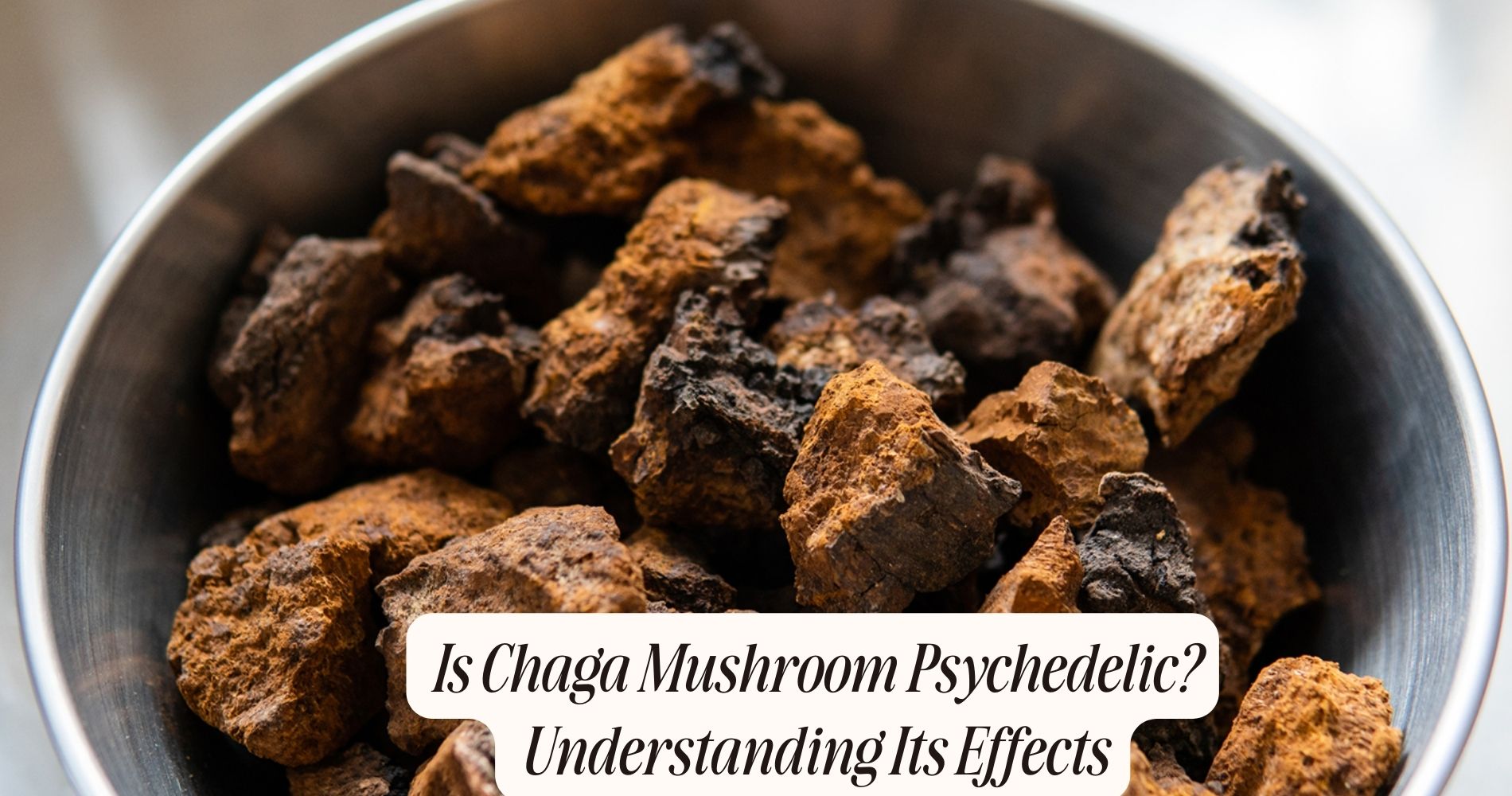
Is Chaga Mushroom Psychedelic? Understanding Its Effects
Is chaga mushroom psychedelic? Chaga mushroom (Inonotus obliquus) isn't psychoactive and doesn't induce hallucinations. Unlike psilocybin mushrooms, it lacks compounds like psilocin that alter perception. Instead, Chaga offers health benefits due to its polysaccharides, melanins, triterpenoids, and polyphenols, which support your immune system, reduce inflammation, and combat oxidative stress. Consuming Chaga can enhance your overall wellness, but it won't produce mind-altering effects. You can enjoy its benefits by incorporating it into teas, tinctures, or food without worrying about psychedelic responses. Discover the depth of its medicinal properties and how they can fit into your lifestyle.
What Is Chaga Mushroom?
Chaga mushroom (Inonotus obliquus) is a parasitic fungus that primarily grows on birch trees in cold climates. It's found in regions like Siberia, northern Canada, and Alaska. This mushroom stands out due to its irregular, blackened appearance, often resembling burnt charcoal. Despite its unassuming look, Chaga has a rich history and significant potential for cultivation.
Historically, Chaga has been utilized for centuries, especially in Russian and Northern European folk medicine. Documentation from the 16th century highlights its use for improving overall health and treating various ailments. Indigenous Siberian tribes also revered Chaga, incorporating it into their diets and medicinal practices.

Today, Chaga cultivation involves mimicking its natural growing conditions. Cultivators inoculate birch trees with Chaga spores, allowing the fungus to parasitize the host tree. This method guarantees a sustainable supply without depleting wild populations. Proper cultivation is vital; it can take up to 20 years for Chaga to mature in the wild, though cultivated methods can shorten this time.
Understanding Chaga's growth and historical use is fundamental before diving into its chemical composition and potential effects. You'll find that Chaga's storied past and careful cultivation contribute to its current status as a sought-after natural remedy.
Chemical Composition of Chaga
To fully appreciate its health benefits, it's important to examine the intricate chemical composition of Chaga mushroom.
Chaga (Inonotus obliquus), a parasitic fungus primarily found on birch trees, contains a unique array of chemical compounds contributing to its medicinal properties. These include polysaccharides, melanins, triterpenoids, and polyphenols.
Polysaccharides, especially beta-glucans, play a pivotal role in immune modulation. They can stimulate the production of immune cells and enhance their activity.
Melanins give Chaga its characteristic dark color and act as potent antioxidants, protecting cells from oxidative stress.
Triterpenoids, like betulin and betulinic acid, derived from the host birch tree, exhibit anti-inflammatory and antiviral activities.
Polyphenols, including flavonoids and phenolic acids, contribute further to Chaga's antioxidant capacity. These compounds scavenge free radicals, reducing cellular damage and inflammation.
Additionally, Chaga is rich in essential minerals like potassium, magnesium, and zinc, which support various physiological functions.
Understanding these chemical compounds helps you grasp why Chaga has been traditionally harnessed for its medicinal properties.
This foundational knowledge sets the stage for exploring the specific health benefits Chaga offers, which you'll investigate into next.
Health Benefits of Chaga
Many have turned to Chaga mushroom for its potential health benefits, backed by scientific studies highlighting its antioxidant, anti-inflammatory, and immune-boosting properties.
Inonotus obliquus, commonly known as Chaga, is a parasitic fungus found on birch trees in cold climates. It's packed with bioactive compounds like polysaccharides, betulinic acid, and polyphenols.
One of the primary chaga benefits is its antioxidant capacity. Chaga contains high levels of superoxide dismutase (SOD), which helps neutralize free radicals, reducing oxidative stress. This action is essential for preventing cellular damage and supporting overall health.

Chaga's anti-inflammatory properties are also well-documented. Research shows that it can inhibit the production of pro-inflammatory cytokines. This can be particularly beneficial for individuals dealing with chronic inflammation, potentially alleviating conditions like arthritis.
For immune support, Chaga is a powerhouse. Its polysaccharides, especially beta-glucans, enhance the activity of white blood cells, key players in your immune system. Studies indicate that these compounds can boost the body's ability to fight off infections and even slow the growth of certain cancers.
Incorporating Chaga into your routine can offer numerous health advantages, making it a valuable addition to a balanced diet.
Psychedelic Mushrooms Explained
Psychedelic mushrooms, primarily Psilocybe species, contain psychoactive compounds like psilocybin and psilocin that alter perception, mood, and cognition. These fungi have been used for centuries in various cultures for their mind-altering effects, which are collectively known as a psychedelic experience.
When you consume these mushrooms, your body converts psilocybin into psilocin, which interacts with serotonin receptors in your brain, leading to altered states of consciousness, visual and auditory hallucinations, and profound changes in thought processes.
In terms of mushroom classification, Psilocybe mushrooms belong to the family Hymenogastraceae. There are over 180 species of Psilocybe, with Psilocybe cubensis and Psilocybe semilanceata being among the most well-known. These mushrooms are typically small, with brown or yellowish caps, and grow in various habitats, including decaying wood, dung, and grassy areas.
Scientific studies have shown that psilocybin has potential therapeutic benefits, such as reducing symptoms of depression, anxiety, and PTSD. However, it's crucial to distinguish between these mushrooms and other non-psychoactive species.
The psychedelic experience they induce is profound and should be approached with caution, given their powerful effects on the mind and body.
Chaga Vs. Psychedelic Mushrooms
While psychedelic mushrooms contain psychoactive compounds that alter perception and cognition, Chaga mushrooms (Inonotus obliquus) are renowned for their medicinal properties and don't induce any hallucinogenic effects.
Chaga mushrooms are primarily used for their potential health benefits, which include immune support, anti-inflammatory properties, and antioxidant activity. In contrast, psychedelic mushrooms, such as Psilocybe cubensis, produce mind-altering experiences due to the presence of psychoactive substances like psilocybin.
Chaga uses have been documented in traditional medicine, particularly in Siberia and other parts of Asia. It's commonly consumed as a tea or supplement, aimed at enhancing overall well-being.

On the other hand, psychedelic mushrooms are often used in controlled settings for therapeutic purposes, such as treating depression or PTSD, but they're also known for recreational use.
There are some chaga myths that suggest it can produce psychedelic effects, but these are unfounded. Scientifically, Chaga contains no compounds that would cause hallucinations or altered states of consciousness.
When comparing Chaga to psychedelic mushrooms, it's clear they serve different purposes and have distinct biochemical profiles, making their effects and uses non-overlapping.
Chaga's Effects on the Mind
Exploring Chaga's effects on the mind reveals its potential to support cognitive function and reduce stress through its rich antioxidant and anti-inflammatory compounds. The Chaga mushroom (Inonotus obliquus) contains a plethora of bioactive substances, including polysaccharides and polyphenols, that contribute to cognitive enhancement. By combating oxidative stress, these compounds protect neurons and support mental clarity.
Research indicates that Chaga's beta-glucans aid in modulating the immune system, indirectly benefiting brain health. When your immune system functions effectively, your brain is less likely to be affected by systemic inflammation, a known factor in cognitive decline. Additionally, Chaga's high melanin content helps protect brain cells from oxidative damage, which can maintain mental clarity.
Scientific studies have also pointed to Chaga's adaptogenic properties, which help the body resist physical, chemical, and biological stressors. This adaptogenic effect can reduce stress levels, further promoting cognitive function. The mushroom's potential to lower cortisol levels, a hormone associated with stress, is particularly beneficial for maintaining mental clarity and focus.
While more research is needed to fully understand Chaga's effects on the mind, current evidence suggests that its antioxidant and anti-inflammatory properties offer promising benefits for cognitive enhancement and mental clarity.
Safety and Side Effects
Understanding Chaga mushroom's safety and side effects guarantees you can make informed decisions about its use.
Scientifically known as Inonotus obliquus, Chaga is generally regarded as safe, but it's important to be aware of potential issues. Chaga toxicity is rare, but possible if consumed in excessive amounts. The mushroom contains oxalates, which in high doses, can interfere with nutrient absorption and may lead to kidney issues.

You should also be aware of allergic reactions. Though uncommon, some individuals may experience reactions like itching, swelling, or respiratory issues when consuming Chaga. If you have a history of allergies, it's wise to start with a small dose and monitor your body's response.
Moreover, Chaga can interact with medications. It has blood-thinning properties, which can amplify the effects of anticoagulants and increase the risk of bleeding. If you're taking medication for diabetes, be cautious, as Chaga may lower blood sugar levels, potentially causing hypoglycemia.
How to Use Chaga
Knowing the potential side effects, you can now explore the most effective methods for incorporating Chaga into your routine.
Chaga (Inonotus obliquus) can be consumed in various forms, with Chaga tea being one of the most popular choices. To prepare Chaga tea, you'll need dried Chaga chunks or powder. Simply simmer about 8-10 grams of Chaga in a liter of water for at least an hour to extract its beneficial compounds, such as beta-glucans and antioxidants.
Chaga recipes can also include tinctures, which involve soaking Chaga in alcohol to create a concentrated extract. This method is effective for harnessing its bioactive components, and you can add a few drops to your beverages or directly under your tongue.
For a more culinary approach, incorporate Chaga powder into smoothies, soups, or even baked goods. This method allows you to enjoy its health benefits without altering the flavor profile of your dishes considerably.
Experience the Benefits of SUPER MUSHROOM GUMMIES
While understanding the effects of Chaga mushroom, consider enhancing your wellness routine with Well Gummies' SUPER MUSHROOM GUMMIES. This convenient gum chew product is packed with 10 types of functional mushrooms, including Chaga. Our vegan gummies fuel your brain and energize your body naturally, providing calmer energy, sharper focus, and immune support for a balanced body and clear mind.
Enjoy the delightful taste of fresh wild berries, as delicious as your favorite candy. Experience the benefits without the jitters or crash, allowing you to shine all day. Incorporate SUPER MUSHROOM GUMMIES into your daily routine and discover a healthier, more vibrant you.
Frequently Asked Questions
Can Chaga Mushrooms Improve Cognitive Function or Mental Clarity?
You can experience cognitive enhancement and improved mental clarity with Chaga mushrooms. Scientific studies suggest that Inonotus obliquus possesses neuroprotective properties, potentially benefiting brain function by reducing oxidative stress and promoting overall mental sharpness.
Are There Traditional Uses of Chaga in Native Cultures?
You'll find that traditional medicine in native cultures often utilizes Chaga mushrooms (Inonotus obliquus) for their cultural significance. Evidence-based studies indicate they've been used for their potential health benefits, including boosting immunity and reducing inflammation.
How Sustainable Is the Harvesting of Chaga Mushrooms?
When considering how sustainable the harvesting of chaga mushrooms is, you should focus on sustainable practices and harvesting ethics. Overharvesting can harm ecosystems, so it's essential to follow guidelines ensuring long-term viability and ecological balance.
What Are the Best Practices for Storing Chaga Mushrooms?
To store chaga mushrooms effectively, you should first use proper drying techniques, such as air-drying or using a dehydrator. Then, place the dried chaga in airtight storage containers to prevent moisture and guarantee longevity.
Can Chaga Mushrooms Interact With Medications or Supplements?
Yes, Chaga interactions with medications or supplements can occur. Always consult your healthcare provider to confirm Chaga safety, as it may affect blood sugar levels, immune response, or interact with anticoagulants and other drugs.
Conclusion
To sum up, while Chaga (Inonotus obliquus) offers numerous health benefits, it's not psychedelic.
Unlike psilocybin mushrooms, Chaga doesn't contain psychoactive compounds. Instead, it's rich in antioxidants, polysaccharides, and betulinic acid, which support immune health and combat oxidative stress.
Always consult scientific literature and your healthcare provider for accurate information on Chaga's effects and safe usage.
So, while it's a potent medicinal fungus, don't expect any mind-altering experiences from Chaga.




